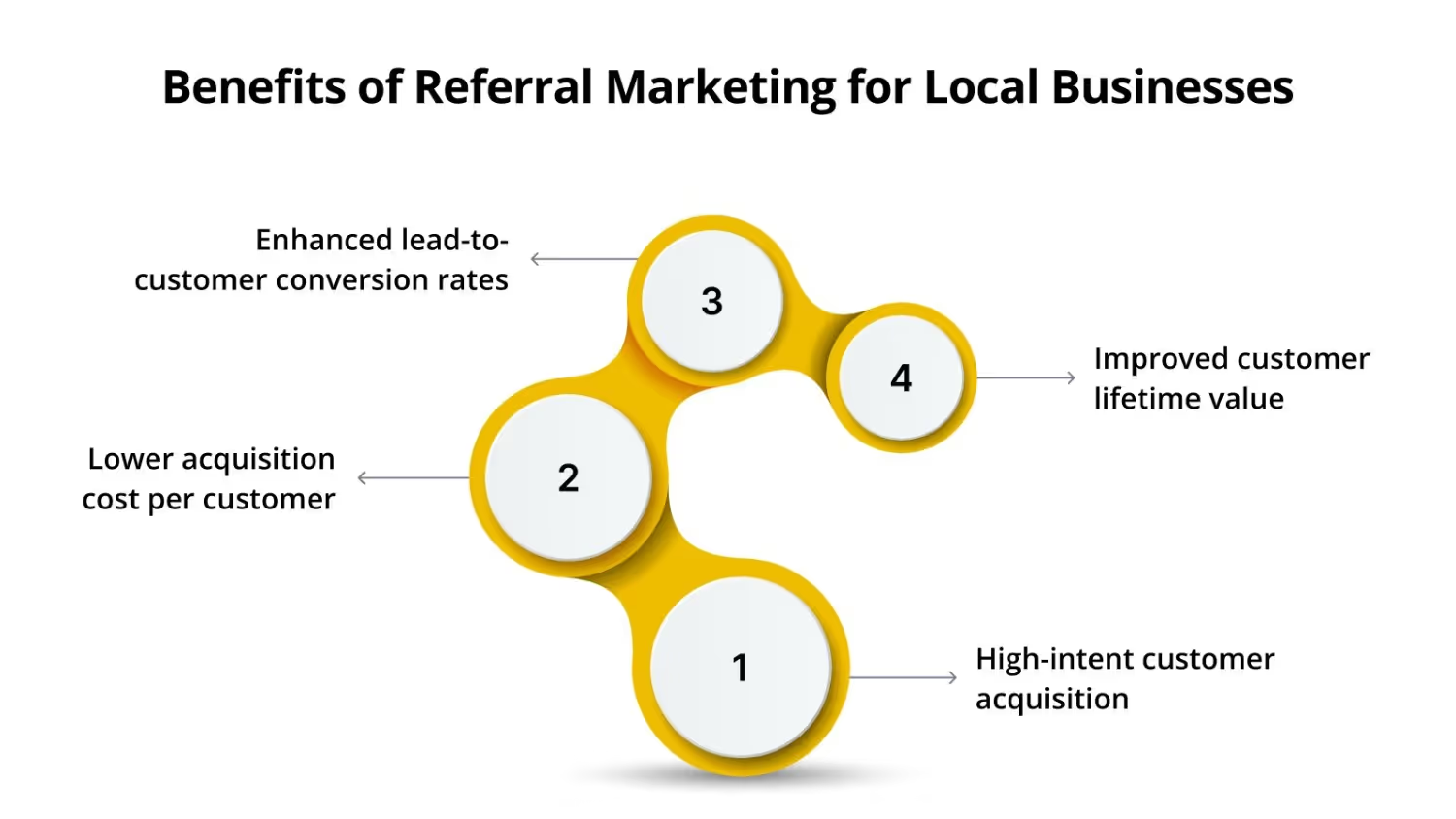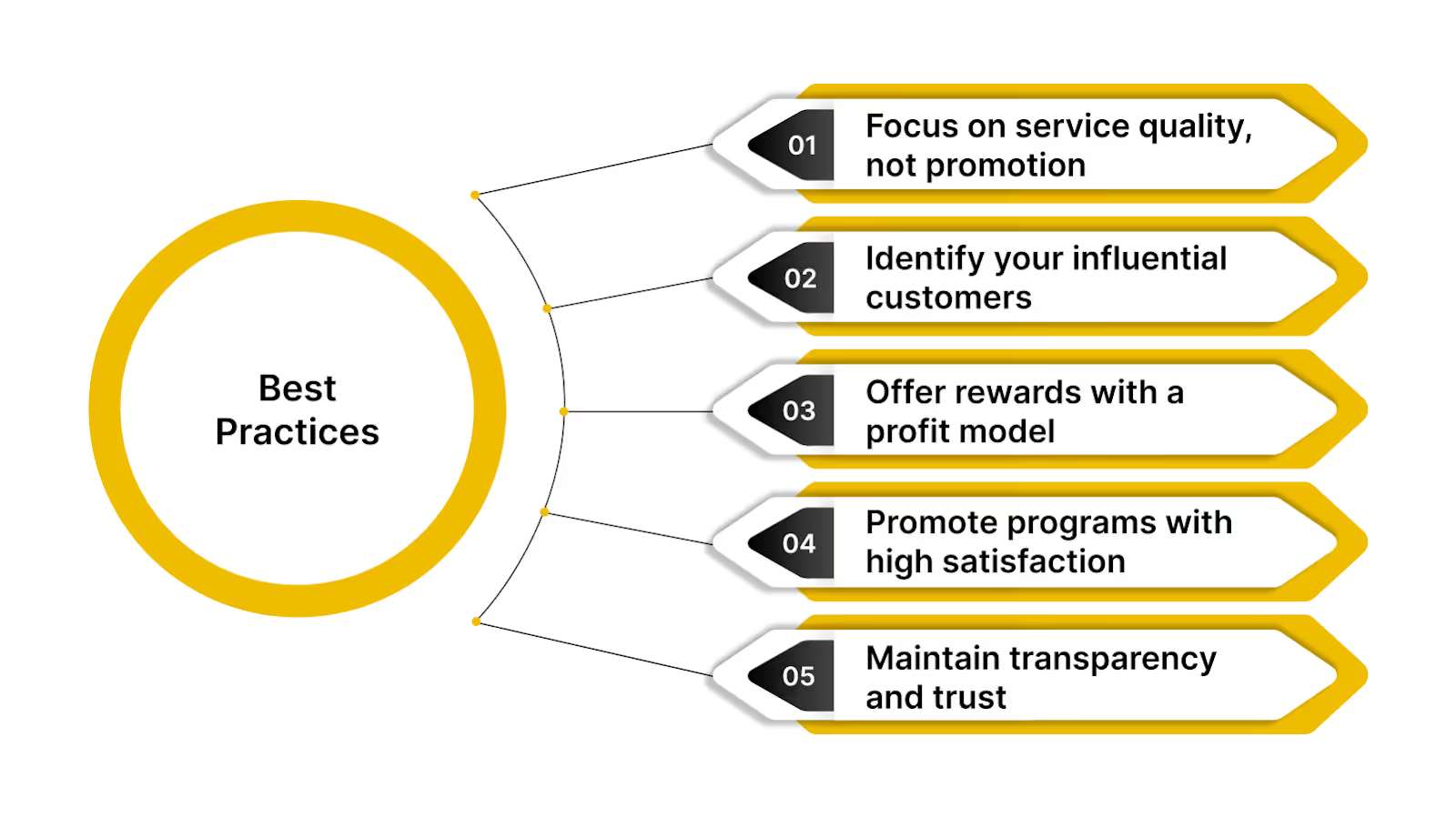.avif)
.avif)
A referral program actively rewards satisfied customers for bringing in friends, family, or peers. Growing a business without overspending on ads or pursuing low-quality leads presents a challenge for many small business owners. In 2025, 84% of consumers discover new products through conversations both online and offline, demonstrating the power of personal recommendations in influencing purchases. Referral marketing enables local businesses to use this trust and convert community connections into tangible growth.
In this blog, we will understand how to design a referral marketing strategy that converts buyers into committed advocates for local businesses.
At a glance:
- Referral marketing for small businesses uses trust and community connections to attract high-intent customers while reducing acquisition costs and enhancing customer lifetime value.
- Strategies include structuring referral programs with effective incentives, clear eligibility rules, fraud prevention measures, and performance tracking to ensure sustainable, measurable, and profitable growth.
- Promoting referral programs during peak customer engagement with timely prompts and multi-channel communication increases participation rates and drives more successful referral conversions.
- Best practices, actionable steps, and compliance considerations align referral activities with business objectives while maintaining transparency, customer trust, and consistent performance.
Benefits of Referral Marketing for Local Businesses

For many local businesses, referral marketing is now a dependable growth engine built on trust and customer loyalty. In 2025, 65% of new business opportunities are reported to come directly from referrals and recommendations.
Here are some of the key benefits of referral programs for local businesses:
- High-intent customer acquisition: Referral leads usually enter your funnel with pre-qualified interest, reducing the need for lengthy awareness campaigns and shortening the sales cycle.
- Lower acquisition cost per customer: Referral programs depend on existing relationships; therefore, the marginal cost of acquiring each new customer is reduced, freeing resources from retention initiatives.
- Enhanced lead-to-customer conversion rates: The inclusion of social proof within a referral program streamlines decision-making capabilities, resulting in fewer follow-ups and increased opportunities for closing.
- Improved customer lifetime value: Referred-acquired customers exhibit stronger initial loyalty, with an increased likelihood of repeat transactions and higher customer lifetime value (CLV).
Also read: How to Build an Easy Referral Program in 2025
Let’s now understand how to create a strategy for developing a referral program for small businesses.
Strategy to Build a Successful Referral Program for Local Businesses

A high-performing referral program is a system that defines clear goals, clean tracking, the right incentives, and steady promotion that turns customers into repeatable acquisitions
Here’s a step-by-step guide to developing a prominent referral program:
Step 1: Define Outcomes
Set a primary goal, such as acquiring new customers, increasing the average order value, or boosting repeat bookings, and select events, including leads or repeat purchases. Establish CAC payback limits, monthly budget caps, and refund or cancellation windows so rewards do not outpace margins.
Step 2: Identify the Best Referrers
Segment customers by satisfaction and recency/frequency to find those most likely to refer. Exclude ineligible groups, such as employees and affiliates, and establish rules for who can be referred.
Step 3: Select a Sustainable Reward Design:
Select single- or double-sided rewards and tie their value to expected profits, such as store credit, discount tiers, or exclusive perks. Add tiering or limited-time boosts to increase momentum, while capping per-customer rewards for referrals.
Step 4: Make Effortless Referrals
Provide each customer with a unique link and QR code that works in-store and online. Prefill share messages for SMS, email, and social media to reduce marketing issues.
Step 5: Integrate End-to-End Tracking
Connect your e-commerce, POS, and CRM so that referrals, purchases, and approvals are synchronized automatically. Utilize UTMs or deep links to attribute visits and conversions.
Step 6: Measure and Fine-Tune Referral Program
Review referral sends, approvals, conversions, and revenue from referred customers, as well as reward costs. Conduct an A/B test on reward type and adjust it accordingly based on the season or category.
To implement a successful referral program, let’s examine some actionable practices for effective referral programs.
Best Practices for Referral Programs for Small Businesses

In 2025, 88% of consumers report trusting online reviews as much as recommendations from personal contacts. For small businesses, this establishes how referral programs and customer reviews work; however, a direct referral carries the added weight of personal connection.
Here are some of the best practices for a successful referral program:
- Prioritize service quality over promotion: A referral program will only be effective if the core product or service consistently meets or exceeds expectations. Happy customers are far more likely to recommend you without hesitation.
- Identify your influential customers: Use purchase history, engagement data, or loyalty program insights to find those most likely to refer. Tailor communication to them with personalized messages or exclusive referral perks.
- Offer rewards with a profit model: Choose incentives that motivate without margins, such as store credit, tiered discounts, or exclusive experiences, encouraging repeat business.
- Promote programs with high satisfaction: Introduce referral prompts right after positive interactions, such as post-purchase, following a favorable review, when customer engagement to recommend is at its highest.
- Maintain transparency and trust: Clearly explain how the referral program works, including any limitations or timelines. This prevents misunderstandings and helps participants feel confident about joining and sharing your program.
Also read: Essential Referral Strategies for Business Growth
Let’s now understand the importance of referral marketing for small businesses with a practical case study.
Real World Case Study for a Successful Referral Program
A rapidly growing baby care retailer found success by combining loyalty and referral strategies to turn satisfied parents into both repeat buyers and brand advocates. Loyalty incentives proved powerful, with about 9.31% of the brand’s revenue coming directly from loyalty-driven purchases, showing how rewards can encourage repeat sales.
Engagement was strong too; customers redeemed loyalty coins at a rate of 32.3%, a clear sign that the rewards felt valuable and worth pursuing. On the referral side, the program achieved an impressive 45% monthly completion rate, meaning nearly half of all sent invitations converted into successful referrals with little friction.
To strengthen this momentum, the retailer took a multi-channel approach, weaving loyalty points, VIP tiers, and referral rewards into the customer journey through post-purchase touchpoints and social prompts, creating a seamless and motivating experience for parents.
Create an Engaging Referral Marketing Program with Nector
Nector helps you turn loyal customers into advocates by combining referrals, loyalty rewards, and reviews in one easy-to-use platform. It integrates with over 50 tools, including Klaviyo, Mailchimp, Judge.me, and Shopify. These integrations enable automated, well-timed referral campaigns without adding manual workload.
You can trigger referral prompts after taking positive actions, such as leaving a review or reaching a purchase milestone. The platform centralizes setup, tracking, and reward management for easy control and management. This structure saves you time while driving steady, measurable growth in referrals.
Sign up now and turn satisfied customers into loyal advocates who bring you new business.

Wrapping Up
Effective referral program management involves refining incentive structures, timing referral prompts during peak customer engagement periods, and tracking key metrics such as the referral-to-purchase rate and revenue impact. It’s essential to identify your strongest advocates, set transparent eligibility rules, and test variations in rewards and communication to see what drives the highest-quality referrals. Controlled, data-driven adjustments ensure your program stays aligned with both customer behavior and business goals.
Strengthen your referral marketing efforts and turn satisfied customers into active brand advocates. Let Nector help you create referral programs that deliver consistent, trackable results. Book a demo with us today!
FAQs
How can local businesses track referral program ROI accurately?
Local businesses can track ROI by using referral tracking tools that incorporate UTM parameters, unique referral codes, and CRM integration. This makes it easier to link each referral to actual sales. To measure performance, compare the revenue generated from referred customers with the cost of rewards to determine net profit. Reviewing these metrics on a monthly basis helps identify trends and adjust the program for better results.
What is the ideal referral-to-purchase conversion rate benchmark?
A healthy benchmark is 20-40%, depending on the industry and reward type. Track monthly, compare against past performance, and adjust incentives or timing for improvement.
How do anti-fraud measures work in referral programs?
Anti-fraud measures block duplicate accounts, self-referrals, and suspicious IP matches. Implement verification steps, hold rewards until return windows close, and review high-value transactions manually.
How often should referral rewards be reviewed or updated?
Review every quarter to ensure profitability and engagement. Analyze redemption rates, conversion rates, and customer acquisition costs before adjusting reward value or structure.
What metrics show long-term referral program success?
Key metrics include customer lifetime value from referrals, repeat purchase frequency, and referral share of total revenue. Track these over 6–12 months for accuracy.
Start Building Customer Retention That Lasts






%201.webp)
%201.webp)

